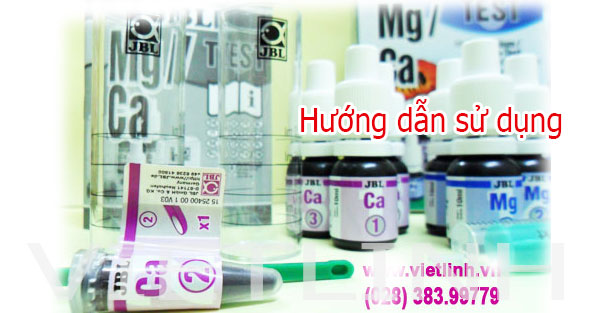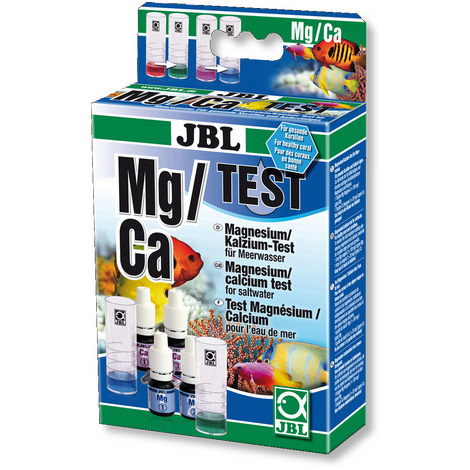
Ứng dụng: Kiểm tra hàm lượng canxi, magiê (Ca, Mg) trong môi trường nước mặn (ao nuôi trồng thuỷ sản, bể cá cảnh, bể thủy sinh).
Hướng dẫn sử dụng:
Chú ý: Lắc đều các chai thuốc thử trước khi sử dụng. Rửa sạch ống lấy mẫu sau mỗi lần sử dụng.
Xác định tổng hàm lượng Mg + Ca:
1. Tráng kỹ ống đựng mẫu nhiều lần bằng nước cần kiểm tra.
2. Dùng xylanh lấy 5ml nước cần kiểm tra vào ống đựng mẫu. Lau khô bên ngoài lọ.
3. Cho 5 giọt thuốc thử 1 (Mg) vào lọ chứa mẫu nước cần kiểm tra, lắc nhẹ. Chờ 1 phút.
4. Nhỏ từng giọt thuốc thử 2 (Mg) vào lọ. Đếm số giọt và lắc đều mỗi khi nhỏ thuốc thử cho đến khi dung dịch chuyển từ màu đỏ sang màu xanh lá cây (green). Lấy số giọt thuốc thử 2 (Mg) đếm được nhân với 120 sẽ được kết quả của hàm lượng Mg + Ca, đơn vị là ppm (mg/L)
Xác định hàm lượng Ca:
1. Tráng kỹ ống đựng mẫu nhiều lần bằng nước cần kiểm tra.
2. Dùng xylanh lấy 5ml nước cần kiểm tra vào ống đựng mẫu. Lau khô bên ngoài lọ.
3. Cho 5 giọt thuốc thử 1 (Ca) vào lọ chứa mẫu nước cần kiểm tra, lắc nhẹ. Chờ 1 phút.
4. Thêm một muỗng (đầu nhỏ) hóa chất 2 (Ca) và lắc đều cho tan hết.
5. Nhỏ từng giọt thuốc thử 3 (Ca), đếm số giọt và lắc đều mỗi khi nhỏ thuốc thử cho đến khi dung dịch chuyển từ màu hồng sang màu xanh (blue). Lấy số giọt thuốc thử 3 (Ca) đếm được nhân với 20 sẽ được kết quả hàm lượng Ca, đơn vị là ppm (mg/L).
Xác định hàm lượng Mg:
Hàm lượng Mg được xác định bằng cách lấy hàm lượng tổng (Mg+Ca) trừ đi hàm lượng Ca.
Bảo quản: Đóng nắp chai thuốc thử ngay sau khi sử dụng. Lưu trữ nơi thoáng mát. Tránh xa tầm tay trẻ em.
* Xem hướng dẫn sử dụng các hộp test khác
* Nhấn vào đây để xem bản Hướng dẫn sử dụng (Tiếng Anh)
Suggested value in saltwater aquariums:
Ca: 400-440 mg/l, Mg: 1200-1400 mg/l
First the magnesium level is determined, including calcium. Then the calcium is measured and subtracted from the total value.
The set includes both tests (Ca-Test + Mg-Test).
Insufficient levels of and magnesium affect the growth of corals and stunt the growth of the attractive red calciferous algae.
Test Set Mg + Ca
Special features:
The JBL Mg + Ca test set is an easy to use drop test to measure the magnesium and
calcium content of saltwater. As the magnesium content can only be measured by
recording the sum of magnesium plus calcium, the two tests have been combined
in one pack. The magnesium content can be calculated by subtracting the calcium
content from the total value of Mg + Ca.
Magnesium:
Why test?
The popular red calcareous algae and invertebrate animals in reef aquariums which
form calcareous skeletons or shells need sufficient quantities of magnesium as well
as calcium to form healthy skeletons and shells. In addition to hard corals this group
includes soft corals, sponges, sea urchins, crustaceans, bivalves, slugs etc. The
magnesium content in marine aquariums should be approximately 1200 mg/l as
measured during the JBL Expedition in the Indo-Pacific.
Help for low levels:
Magnesium levels which are too low can be easily and safely increased with JBL
MagnesiuMarin.
Calcium:
Why test?
Lower animals (corals, shellfish etc.) and calcareous algae in sea water require
sufficient levels of calcium for healthy growth. The natural calcium level of the sea
is 390 - 440 mg/l. In order that the organism can make the best use of the calcium,
hydrogen carbonate must also be present in the water in the correct proportions. For
this reason the addition of calcium compounds without hydrogen carbonate, such
as calcium chloride, is pointless. A calcium level of 400 - 440 mg/l has proved to be
the optimum in marine aquariums.
Help for low levels
Calcium levels which are too low can easily be raised with JBL CalciuMarin. JBL
CalciuMarin contains the correct proportions of calcium and hydrogen carbonate, so
that the targeted organisms have the best possible access to the calcium. Calcium
reactors (available at specialist pet shops) also help attain the physiologically
correct increase in calcium levels.
Procedure:
NOTE: Always hold the dropper pointing vertically downwards when taking
drops from drop bottle. Exterior surface of dropper should be dry. Avoid bubbles.
Failure to follow with these precautions may lead to deviations in the test results.
Measuring the total Mg + Ca:
1. Swill out the measuring vessel several times with the water to be tested.
2. Fill the measuring vessel to the 5ml mark with the water to be tested. We strongly
recommend that the enclosed syringe is used for exact results.
3. Add 5 drops of reagent 1 and shake to mix. Wait 1 minute.
4. Add Mg reagent 2 one drop at a time, counting the drops, and shake after each
drop until the colour changes from red via grey-brown to green. The number of
the drops used multiplied by 120 gives the sum of the Mg + Ca content in mg/l.
Example: 14 drops Mg reagent 2 = 1680 mg/l Mg + Ca
5. The magnesium content is found by subtracting the calcium content. Example:
Ca 400 mg/l (test as described below). 1680 mg/l minus 400 mg/l gives a
magnesium content of 1280 mg /l.
Note: If a more precise result for the total Mg + Ca is required, 10 ml of sample
water should be used in Step 1 and the number of drops in Step 4 multiplied by 60.
All other steps remain as described above.
Measuring Ca:
1. Repeatedly rinse the measuring vessel with the water to be tested.
2. Fill the measuring vessel to the 5ml mark with the water to be tested. Use the
enclosed syringe for exact results.
3. Add 5 drops of reagent 1 and shake it to mix. The test result is not affected by any
clouding which may occur. Wait 1 minute.
4. Add 1 small measuring spoonful (narrow end of the enclosed double-ended
spoon) of reagent 2 and shake it until the powder has dissolved.
5. Add reagent 3 one drop at a time, counting the drops, and shake it after each
drop until the colour changes from pink via violet to blue. The number of drops
needed multiplied by 20 gives the calcium content in mg/l. Example: 12 drops of
reagent 3 = 240 mg/l.
Our tip for environmentally-friendly users
All reagents for JBL test sets are available from your retailer as reasonably-priced
refill packs!

* Xem hướng dẫn sử dụng các hộp test khác









